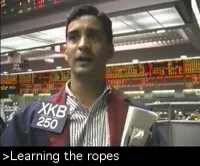 |
 |
 |
 |
 |
 |
 |
 |
 |
 |
 |
 |
 |
 |
 |
 |
|
Wall Street Firms and Their History "Despite the Boom Times J.P. Morgan Still Can't Make it on Wall Street," Fortune, April 13, 1988. Discusses the performance of JP Morgan the company's strategy for the next few years. The Global Gamble, Business Week, February 12, 1996. Story about Morgan Stanley's expansion into emerging markets. "India is far from the only place Morgan Stanley is planting its banner. The firm has been opening offices, raiding local talent, and scrambling for deals from Beijing to Johannesburg to Sao Paulo. Morgan is betting that the capitalist revolution sweeping through much of the world is irreversible and that newly minted free markets will generate red-hot economic growth and, eventually, profits. "High growth rates create wealth," says chairman Richard B. Fisher, "Wealth is what generates business for us." "Intelligent Relationships," Red Herring, April 1995. A stable bulge bracket of firms dominates technology investment banking. "If You're Thinking of Buying an Investment Bank," Fortune, April 13, 1988. Discusses the ongoing consolidation of investment banking. Gives you a good picture of why the consolidation is happening. Investment Banking: A Tale of Three Cities, by Samuel L. Hayes III and Philip M. Hubbard, Harvard Business School Press, 1990, (617) 495-6700. Does a nice job of covering the economic workings and history of investment banking. Good background reading. |
|
|
||||||||||||||||||||||||||||||||
|
Investment Banking: The Art and Science of High Stakes Deal-Making by Robert L. Kuhn, Harper & Row, 1990. Defines investment banking with lots of "how-to" and war stories. Long-Term Greedy: The Triumph of Goldman Sachs, by Nils Lindskooq, 1998. Lindskoog tells the story of the investment banking firm Goldman Sachs from the point of view of his position as a mergers and acquisition specialist at a company that hired Goldman Sachs to help fight off a hostile takeover bid. Lindskoog's massive work details how the junk bond market initially threatened Goldman, explains what tactics the investment bank developed to defend against unwanted takeovers, and shows how it in turn prospered defending its clients. Merrill Lynch Bulls Ahead, Fortune, February 19, 1996. Talks about how Merrill Lynch has surged in the 1990s and how it is now positioned as a premiere investment bank with a unique culture set by its Chairman. "One Helluva Candy Store!," Fortune, May 11, 1998. That's what Sandy Weill calls the megameld of his Travelers Group and John Reed's Citicorp. Can Citigroup's odd couple make it pay? Secrets of the Street, by Gene Marcial, 1995. A juicy book written by a noted BusinessWeek columnist. Tell all on how firms really work Wall St. Serpent on the Rock, by Kurt Eichenwald, HarperBusiness, $27.50. This account of the travails of Pru-Bache in a securities scandal involving limited partnerships. This is a study of a money hungry organization that was willing to break its trust with its customers. Read the book to understand how it could happen. "So You'd Like to be a Stockbroker?," by Mark Robinson, Business and Finance Career Directory, 1993, Gale Research. Cost:$18. The Vandals Crown: How Rebel Currency Traders Overthrew the World's Central Banks, Free Press, $23.00. Covers the role of important role of investors and traders that move more than $1 trillion a day in currency traders. "Two-Tier Wall Street", New York Times, June 15, 1995, p. 1. A young bond analyst at CS First Boston is denied a bonus while the head of retail investment banking at the same firm gets a $10 million package. Wall Street is increasingly become a world of have's and have nots. Top producers and key personnel get astronomical salaries while strong efforts are in place to cut compensation elsewhere. "What is a Securities Trader?," by John L. Watson, President of Security Traders Association in the Business and Finance Career Directory, 1993, Gale Research. (800) 877-GALE. Cost: $18. The Wall Street Journal Guide to Who's Who and What's What on Wall Street, Ballantine Books, 1988. An enormously useful book if you are looking for a position. In addition to giving very good sketches of the leadings firms, it lists over 25 people in each firm and their position. This book definitely falls into the "must have" category. "Why Goldman Sachs Matters," Andy Serwer, Fortune Investor, July 6, 1998. Talks about the IPO of one of Wall Street's leading firms |


